Have you ever wondered how research gets funded? How does the government choose which researchers get money to find a new renewable energy source, or which company gets to work on a vaccine or a cure for cancer, or which apartment offers reduced rents to low-income families, the elderly, and persons with disabilities? This vital funding comes through governmental grants, and the life cycle around that funding – what we call “grants management” – is an area of great opportunity for digital innovation.
This blog is part two of our series on reimagining the public sector via modern APIs. The first article of this series covers a digital future for citizens and the value of composability. In part two, I will explore the case for grants management, showing how value exchange mapping and API-led connectivity can lead from idea to implementation.
When distributing grants to state and local governments, the federal government’s primary consideration is the wellbeing of citizens. The grants management application is vital for administering and automating the grant process. The grant process follows a linear life cycle that includes the following steps:
- Pre-award: Creating the funding opportunity and submitting the application.
- Award: Making award decisions.
- Implementation: Successfully implementing the award.
- Closeout: Auditing submitted documents and reports and closing out the process.

According to a report from the Tax Policy Center, the federal government distributes about $721 billion in grants to states and localities each year. About 61% of those funds went to healthcare, 16% to income security programs, and 9% to transportation, education, training, employment, and social services.
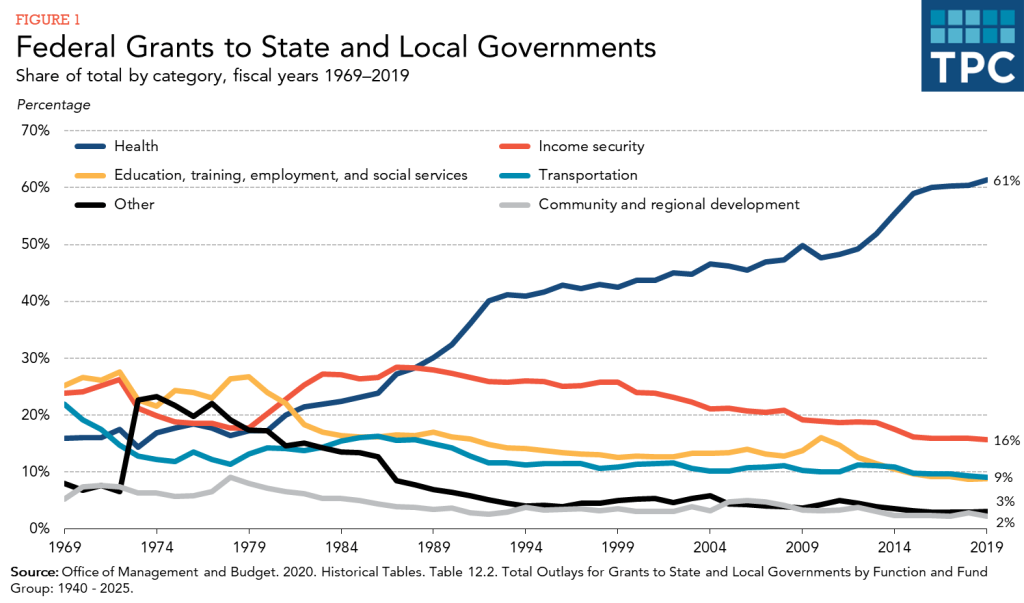
Challenges of grants management
The U.S. Government Accountability Office (GAO) has identified several challenges with federal grants management in its work spanning several decades. These challenges include:
- Streamlining: Requirements that are duplicative and conflicting can burden recipients of federal grants.
- Transparency: Inconsistencies with the completeness and quality of the reported information.
- Collaboration and consultation: Collaboration between grantor and grantee is inefficient and slow, resulting in poor implementation and prioritization of initiatives.
- Duplication, overlap, and fragmentation: Duplication and overlap of grants cost agencies.
- Internal controls and oversight: Weaknesses in grants oversight and accountability.
- Slow: Running on legacy systems or paper-based manual processes.
- Data silos: Difficulty getting data from other lines of business because of inadequate data management strategy.
- Hard to measure: Difficulties reporting and measuring grant outcomes.
Incompleteness and low quality of reported data have impacted data-driven decisions. According to GAO, these decisions have caused improper grant payments estimated at $1.4 trillion since 2003. In addition, unspent funds could be redirected or returned, but often audits aren’t submitted on time or at all.
Without significant change to the grants management process, we will continue to lose trillions of dollars that could be used for critical needs. To solve the above challenges, the GAO proposed initiatives aimed at grants management reform and presented opportunities to improve the efficiency, effectiveness, and transparency of federal grants.
Composability for grants management
To provide first-class citizen experiences, enable wellbeing, and improve government agility, we must reimagine the grant management system using a composable approach. First, let us look into composable business by using “value exchange.” The below picture comes from Melissa Perri’s product management book, Escaping the Build Trap.

In the value exchange diagram above, she depicts businesses that provide products or services to their customers in exchange for money. The customer is willing to pay for a product or service because of the value realized. The value realized can solve the customers’ problems or meet their needs. In the same way, if we borrow the “value exchange” and apply it to federal grants management, we will get the following model.
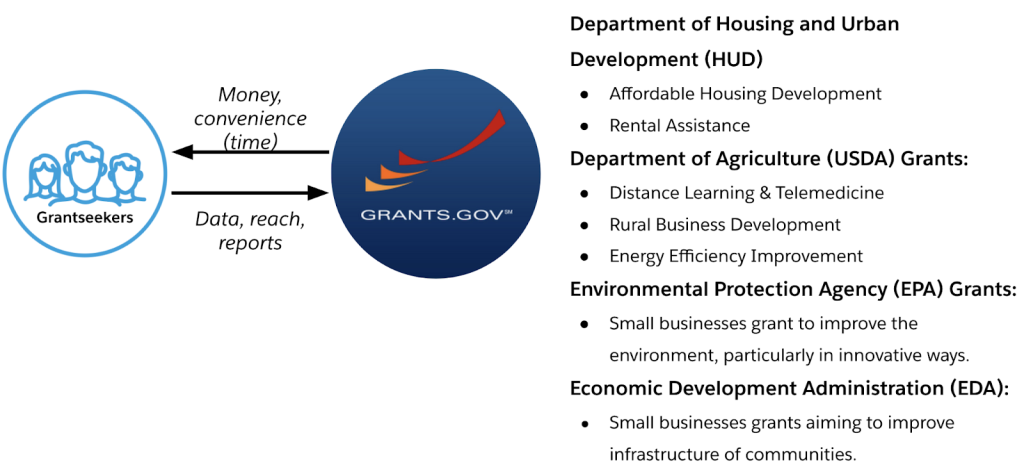
In the grants management business model above, grant seekers will be providing data, reports, and reach in exchange for money and convenience.
Various federal agencies like the Department of Housing and Urban Development (HUD) or the Department of Agriculture (USDA) commonly provide grants to grant seekers to support affordable housing, rental assistance, rural development, energy efficiency improvement, and so on. To provide these grant types to grant seekers, various interactions must take place between grant-providing agencies, the grants.gov website, and other agencies.
As an example, let’s pick one of the grant types at the federal agency and represent the interactions using a value network. If we pick up a rental assistance grant type for HUD, we will get the following value network diagram.
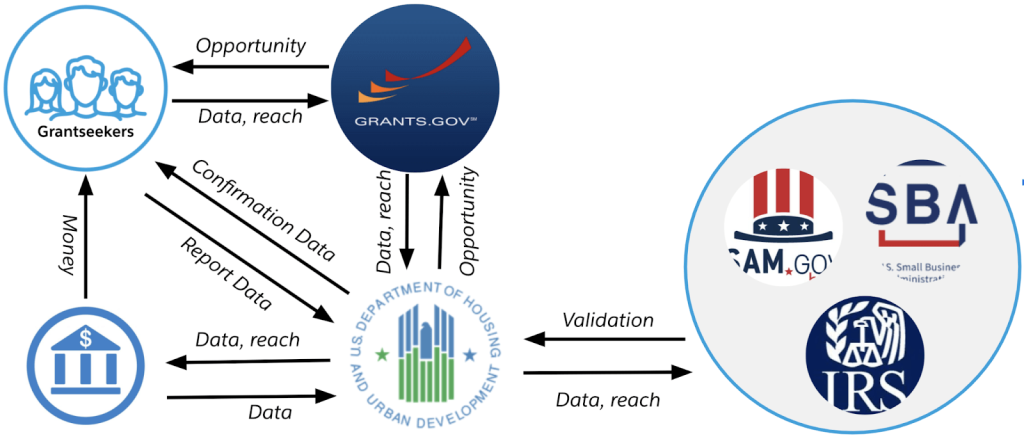
In this value network, HUD would post rental assistance grant opportunities on the grants.gov website for grant seekers to discover. After discovering the opportunity, the grant seeker would apply to the opportunity by providing data and reach which will be validated if necessary. Once the grant seeker is approved, the terms and conditions of money disbursement and reporting would be agreed upon.
Composable enterprise architecture for grants management
If we map the above value network into a composable enterprise by using APIs, we will get a grants management API ecosystem like the one shown in the diagram below. Agencies that provide grants can create different channels to expose the grant types. If the grant seeker wants to apply for any grant type, they can use the mobile application or web portal channels.
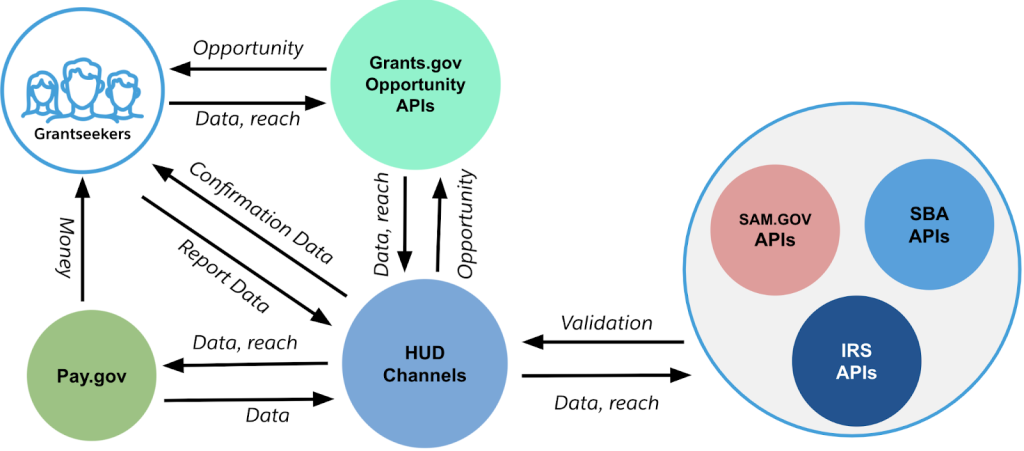
Based on the challenges previously reviewed, grant management solutions should have:
- Single 360-degree view of the grant life cycle for the grantor and grantee to improve transparency and accountability.
- Intelligent interaction between the grantor and grantee for better user experience.
- Real-time decision-making by unlocking data from legacy grants management systems to improve customer experience.
- Ability to measure the outcome of the given opportunity by using the KPIs defined using dashboarding and analytics tools.
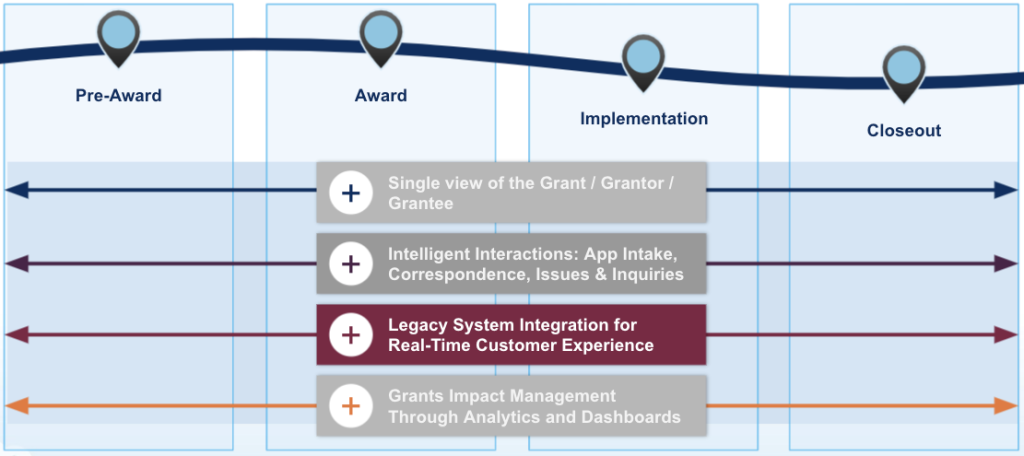
Based on these suggested solutions, if we map the above API ecosystem into MuleSoft’s API-led architecture we will get a composable enterprise architecture on grants management as shown in the image below. The API-led connectivity approach has three layers and APIs in each layer developed to play a specific role. For example, System layer APIs are used to unlock data from systems of records, legacy, and SaaS applications. The Process layer APIs are used to compose data from System layer APIs into processes and the Experience layer is used to deliver an experience via different channels such as mobile, web, IoT, and so on.
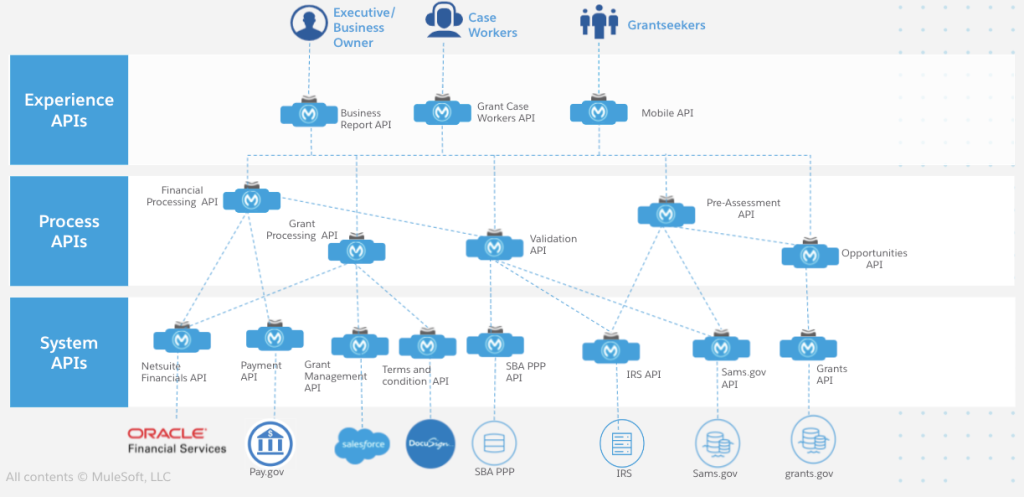
In this API-led architecture, an agency can publish any opportunity to the grants.gov website by using an opportunities API in the Process layer. From there, grant seekers can discover the opportunity using their mobile phone or web app channels. Then grant seekers can quickly check pre-assessment to determine if they are eligible to apply for the given opportunity or not by using a pre-assessment API. If the grant seeker is eligible, they can apply for the grant and will be checked for further conditions by the validation process API. After a successful condition, a grant is awarded and payment will be dispersed by the grantor by using pay.gov payment API. Periodically, reporting will be performed by the grant seekers. Finally, the executive team or business owner will have a 360-degree view of the grant and its business outcome.
Below is the summary of how MuleSoft Anypoint Platform can solve the challenge of grants management according to the GAO recommendations:
- Transparency: Accelerate transparency by rapidly unlocking core data from grant management systems to show auditing, payment, financial, reporting, and other data by using 200+ out-of-the-box MuleSoft Connectors from Anypoint Exchange.
- Efficiency: Design and implement modern APIs using MuleSoft Anypoint Platform that will help to improve data completeness and quality which will improve the efficiency of data-driven decision making.
- Effectiveness: Adopting API-led methodology improves real-time decision-making and intelligence to close out grants on time, identify, and redirect unused funds to other priority projects.
Conclusion
In this article, first, we reviewed the challenges of grants management. Then, we covered how to design a composable business model for grants management by using the value network. Finally, we reviewed a composable architecture for grants management using MuleSoft API-led methodology.
If you want to learn more about grants management and reimagining the public sector via modern APIs, check out the grants management demo. In the next article in this series, I will cover the case for the Department of Motor Vehicles.
Special thanks to Matt McLarty for his contributions to this blog.









